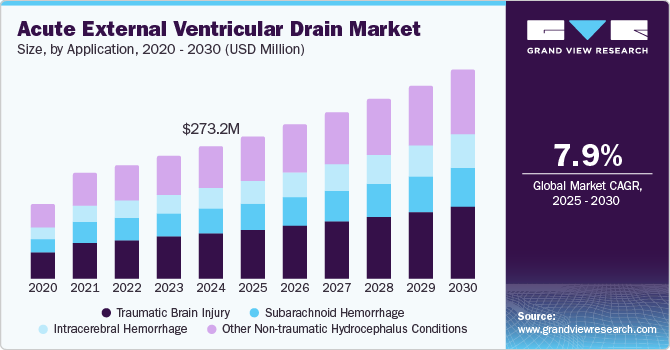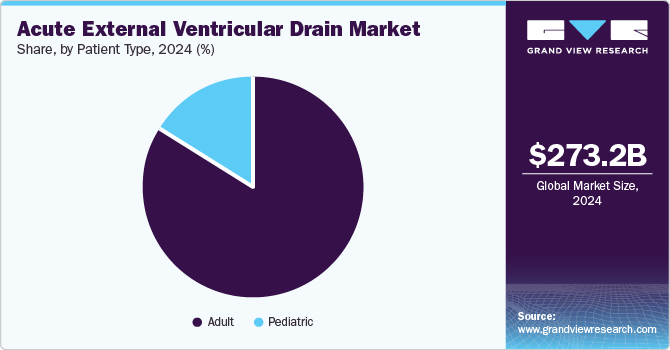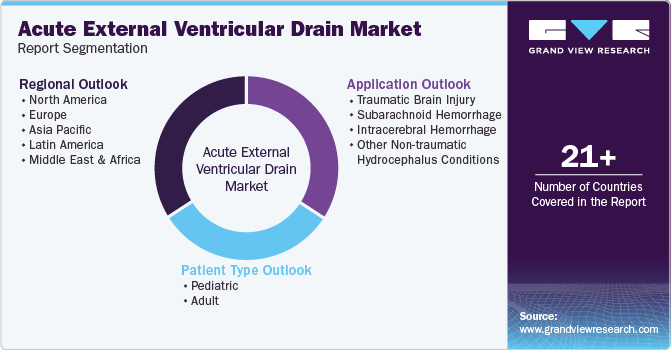
Acute External Ventricular Drain Market Size, Share & Trends Analysis Report By Application (Traumatic Brain Injury, Subarachnoid Hemorrhage, Intracerebral Hemorrhage), By Patient Type (Pediatric, Adult), By Region, And Segment Forecasts, 2025 - 2030
- Report ID: GVR-4-68039-967-2
- Number of Report Pages: 110
- Format: PDF, Horizon Databook
- Historical Range: 2018 - 2023
- Forecast Period: 2025 - 2030
- Industry: Healthcare
Market Size & Trends
The global acute external ventricular drain market size was valued at 273.2 million in 2024 and is projected to grow at a CAGR of 7.9% from 2025 to 2030. The growth is expected to be driven by increased demand for minimal or noninvasive neurosurgeries, the rising prevalence of non-traumatic hydrocephalus, and the rising adoption of technologically improved devices. According to NCBI, the use of external ventricular drain (EVD) catheters in conjunction with intracranial pressure (ICP) monitoring has expanded recently, enabling the recording of ICP waveforms and values during continuous cerebrospinal fluid (CSF) drainage. As a result, the industry is anticipated to witness growth.

Innovations in EVD systems, such as developing more precise and reliable drainage systems, have improved patient outcomes and reduced complications. These advancements are particularly significant in regions including North America and Europe, where the adoption of cutting-edge medical technologies is high. In a survey of 66 European neurotrauma centers, most reported using EVDs when cerebrospinal fluid drainage is expected or when ventricles are enlarged, and they routinely employ IPMs. External ventricular drains are the preferred monitoring method in the USA, Colombia, and China. The growing focus on minimally invasive neurosurgical procedures has also boosted the demand for EVDs. These procedures are preferred due to their reduced recovery times and lower risk of complications.
Advanced devices might simplify surgical procedures, reduce treatment time, and aid in less invasive operations, resulting in market expansion in the near future.
For instance, in December 2019, Raumedic launched a new intracranial pressure monitoring device, Raumed home intracranial pressure, for home use. Such developments are likely to offer neurosurgeons more insights into therapy and enable patients suffering from hydrocephalus patients to lead a more active life. Hence, owing to the aforementioned factors, AEVD is expected to contribute to market growth, providing profitable opportunities for key players post COVID-19.
The increasing prevalence of neurological disorders, such as comprising cerebral hemorrhage with intraventricular extension, acquired brain injury, subarachnoid hemorrhage, hydrocephalus, aneurysm, traumatic brain injury (TBI), and meningitis, is expected to fuel market growth. Several of these conditions are associated with raised intracranial pressure (ICP) or intracranial hypertension above 20 mmHg due to obstruction of cerebrospinal fluid (CSF) outflow. External ventricular drain (EVD) is one of the most commonly performed neurosurgical procedures: More than 25,000 EVDs are inserted annually in the U.S. alone.
Moreover, EVD is frequently used in the management of TBI. EVD implantation has various advantages in TBI. For example, drainage of even modest quantities can considerably decrease ICP; assists in the clearance of hemorrhage from a ventricle, preventing recurrent hydrocephalus; and allows monitoring of ICP via the pressure transducer vent port, offering objective information to guide ICP/CPP-directed therapy. Thus, the rising prevalence of TBI is expected to raise the demand for EVD procedures. For instance, as per CDC data, in 2020, over 64,000 TBI-related fatalities occurred in the U.S., or 176 TBI-related fatalities every day.
Similarly, a research study published in Neurosurgical Focus in 2022 found that TBI affects up to 69 million people annually throughout the world. According to estimates, 1.6 million TBI cases that require neurosurgery happen each year in high-income countries (HICs), compared to 4.5 million cases in lower-middle-income countries (LMICS). Over 2.8 million Americans experience a TBI each year, with 280,000 of them necessitating hospitalization, according to a March 2021 article by the American Society for Biochemistry and Molecular Biology. TBI-related injuries cause close to 50,000 fatalities annually, or 155 fatalities each day. As a result, the high prevalence of TBI is anticipated to be a major driver of market expansion.
Several unique navigation techniques have lately been developed to overcome concerns regarding incorrect EVD placement, neurosonography smartphone-navigated placement, notably frameless stereotaxy, electromagnetic neuronavigation guidance, ultrasound-guided placement, optical neuronavigation, CT guidance, and wearable technologies. A smartphone augmented-reality mobile device application has already been developed, with or without a ventricular catheter-guiding instrument. The use of ultrasound navigation for EVD implantation has become the standard of treatment in the U.K. Ultrasound-guided EVD insertion reduces the possibility of malposition, decreasing the need for numerous insertions attempts and associated morbidities with multiple passes.
Therefore, manufacturers are involved continuously in developing advanced products which is anticipated to boost the industry’s growth in the forthcoming years. For instance, In July 2019, Integra LifeSciences acquired Arkis Biosciences, Inc., which is a private company that offers a portfolio of neurosurgical devices including the CerebroFlo External Ventricular Drainage (EVD) catheter with Endexo technology. This acquisition has strengthened Integra LifeScience’s Neuro-critical care segment.
The development of the coated external ventricular drain is another major factor expected to boost market growth. The IDSA guideline and the American Neurocritical Care Society propose using coated EVDs to prevent ventriculitis and decrease infections associated with EVD. Antimicrobial catheters have been developed for EVDs; however, there have been fewer clinical studies. For instance, in the U.S., VentriClear (Cook, Inc.) is an antibiotic-impregnated catheter containing rifampicin and minocycline, whereas Bactiseal (Codman Integra LifeSciences) includes rifampicin & clindamycin and is available internationally.
Several research studies and clinical trials are being conducted to prove the efficacy of coated EVDs in reducing infections. In addition, coated EVDs are more expensive than noncoated EVDs; however, they are more effective in reducing the rate of infections, and their use is cost-effective.
Application Insights
Traumatic Brain Injury (TBI) dominated the market with 33.9% in 2024 and is expected to grow rapidly from 2025 to 2030. Every year, more than 60 million new cases of traumatic brain injury are reported worldwide. The most common causes are car accidents and falls, both of which are on the rise.
TBI is associated with intracranial hemorrhage, which increases the risk of mortality and disability. The severity of such an injury might range from “mild,” which is defined as a transient change in mental status or consciousness, to “severe,” which is defined as an extended period of amnesia or unconsciousness following the damage. A TBI can cause short- or long-term issues with independent functions.
According to CDC, TBIs have increased considerably over recent years. Based on the recent data, there were 16,070 TBI-related hospitalizations among children (birth to 17 years old) in 2019 and 2,774 TBI-related deaths in 2020. Moreover, the number and rate of TBI-related hospitalizations and deaths were higher among people aged 75 and over. This age group is responsible for around 28% of TBI-related deaths and 32% of TBI-related hospitalizations.
Thus, a high incidence of traumatic brain injuries leads to intraventricular bleeding (hemorrhage), which in turn demands the use of acute EVD products to remove excess cerebrospinal fluid from the brain.
Intracerebral Hemorrhage (ICH) is anticipated to emerge as the fastest-growing segment during the forecast period. ICH is often linked to conditions such as hypertension, smoking, and environmental pollution. These factors contribute to the increased occurrence of ICH, leading to an increased usage of EVDs to manage elevated intracranial pressure and drain excess cerebrospinal fluid (CSF). Moreover, the increasing public and medical community awareness about ICH’s symptoms and long-term impacts has resulted in more frequent and earlier diagnoses, thereby increasing the need for effective management solutions, including EVDs.
Patient Insights
The adult segment held a dominant market share in 2024. The prevalence of hydrocephalus has risen dramatically over time, raising the demand for EVD devices as a treatment option in adults. The increased frequency of neurological illnesses due to road accidents falls, and violence all contribute to the external ventricular drain market's rapid expansion. For instance, as per the European Injury Database (IDB), approximately 6.1 million people are treated in hospitals for injuries every year. These injuries include facial and traumatic brain injuries.

Similarly, according to the CDC report, an estimated 56,000 older people are hospitalized every year as a result of head injuries suffered due to falls, and 775,000 older adults are living with TBI-related disabilities. This is expected to fuel segment growth during the forecast period. Moreover, growing research activities on diagnosis and surgical management, along with several new pipelines of products, are further boosting the industry's growth.
Pediatric patients are expected to boost at a CAGR of 8.1% over the forecast period. The increased frequency of neurological illnesses and other medical conditions, such as subarachnoid hemorrhages, hydrocephalus, intracranial hypertension, head injury, and inflammatory diseases of the cerebrospinal space, are expected to drive the segment.
Hydrocephalus affects one to two out of every 1,000 babies, according to the National Institute of Neurological Disorders and Stroke (NINDS). When the flow of cerebrospinal fluid inside the brain is impeded, an external ventricular drain device is used in neurosurgery to treat and alleviate elevated intracranial pressure and hydrocephalus. During the forecast period, this is expected to fuel market expansion.
Furthermore, various technological advancements and innovations, extensive research and development activities, and a large volume of clinical trials being conducted for the development of traumatic brain injuries and other diseases, as well as an increase in the number of falls and accident cases worldwide, are expected to propel the segment growth.
Regional Insights
The North America acute external ventricular drain market led the global market with the dominant share of 35.3% in 2024. This can be attributed to the high prevalence of TBI and the high incidence of neurovascular illnesses in this region. Moreover, an increase in the number of FDA approvals for acute external ventricular drain products in clinical applications such as head injury, hydrocephalus, subarachnoid hemorrhages, and other diseases of cerebrospinal space are responsible for fueling the regional growth. In addition, increasing government funding and growing initiatives for raising awareness about neurological disorders are among the factors expected to drive the demand for external ventricular drain in this region.

In addition, a favorable reimbursement structure and rising healthcare expenditure contribute to the industry's growth in the country. For instance, according to statistics published on CMS.gov, U.S. healthcare expenditure increased by 9.7% in 2020, reaching USD 4.1 trillion per person and accounting for a 19.7% share of the nation’s GDP. Thus, these factors are likely to boost the growth in the U.S. Furthermore, the favorable reimbursement structure is a major factor contributing to the growth.
U.S. Acute External Ventricular Drain Market Trends
The acute external ventricular drain market in the U.S. is expected to be driven by favorable reimbursement policies over the forecast period. The country with robust healthcare systems, and insurance coverage for neurosurgical procedures, including the use of EVDs, makes these treatments more accessible to a broader patient population. Such financial support encourages hospitals and clinics to adopt advanced EVD technologies, thereby boosting market growth.
Asia Pacific Acute External Ventricular Drain Market Trends
The Asia Pacific acute external ventricular drain market held 25.0% of the market share in 2024 and is expected to boost over the forecast period. Asia Pacific acute external ventricular drain market is primarily driven by the increasing incidence of sports injuries & trauma. Emerging economies, such as China, Japan, South Korea, and India, are expected to witness considerable market growth over the forecast period. The presence of a large patient pool and the growing need for technologically advanced & cost-efficient healthcare solutions are among the factors expected to present significant regional growth opportunities.
Moreover, the market is driven by high-impact R&D investments made by international businesses to reach underserved markets in Asia Pacific, which result in low-cost services and an increase in clinical trials. Other factors supporting market expansion in the region include an increase in hospital admissions and improvements in clinical development frameworks in developing nations. However, the region's expansion could be hampered by a lack of advanced healthcare facilities, a shortage of experienced experts, and a bad reimbursement environment.
Europe Acute External Ventricular Drain Market Trends
The Europe acute external ventricular drain market held 19.1% of the market share in 2024 owing to the aging population in Europe. Such a demographic shift is particularly evident in countries including Germany, France, and Italy, where the aging population has grown rapidly. Additionally, the high rate of road accidents and resultant TBIs in the region have contributed to the market’s growth.
Key Acute External Ventricular Drain Company Insights
Companies are adopting several strategies such as collaborations, launching new products, and increasing their geographic footprint and distribution network by adopting the following strategic initiatives to gain a higher market share. For instance, in October 2021, RAUMEDIC announced the expansion of its manufacturing unit in Mills River, North Carolina, U.S. by February 2022. Similarly, in the same month, Spiegelberg announced its new sales partner, LaboClinic, for Poland. This is expected to help the company increase its presence in Poland. The pandemic has also created opportunities for local manufacturers. Thus, the market is expected to grow considerably in the coming years.
- Natus Medical Incorporated is a leading provider of medical device solutions focused on screening, diagnosing, and treating disorders affecting the brain, neural pathways, and sensory nervous systems.
Key Acute External Ventricular Drain Companies:
The following are the leading companies in the acute external ventricular drain market. These companies collectively hold the largest market share and dictate industry trends.
- Medtronic
- Integra LifeSciences
- Natus
- Fuji Systems
- Spiegelberg GmbH & Co. KG
- Sophysa
- Neuromedex GmbH
Recent Development
-
In July 2023, Integra LifeSciences announced favorable clinical and economic outcomes for the Codman Bactiseal External Ventricular Drain (EVD) catheter set in treating hydrocephalus, a complication arising from aneurysmal subarachnoid hemorrhage (aSAH).
Acute External Ventricular Drain Market Report Scope
|
Report Attribute |
Details |
|
Market size value in 2025 |
USD 294.6 million |
|
Revenue forecast in 2030 |
USD 432.7 million |
|
Growth rate |
CAGR of 7.9% from 2025 to 2030 |
|
Base year for estimation |
2024 |
|
Historical data |
2018 - 2023 |
|
Forecast period |
2025 - 2030 |
|
Quantitative units |
Revenue in USD million and CAGR from 2025 to 2030 |
|
Report coverage |
Revenue forecast, company ranking, competitive landscape, growth factors, and trends |
|
Segments covered |
Application, patient type, region |
|
Regional scope |
North America, Europe, Asia Pacific, Latin America, MEA |
|
Country scope |
U.S., Canada, Germany, UK, France, Italy, Spain, China, Japan, India, South Korea, Australia, Brazil, Argentina, Mexico, Colombia, Saudi Arabia, UAE, South Africa |
|
Key companies profiled |
Medtronic; Integra LifeSciences; Natus; Fuji Systems; Spiegelberg GmbH & Co. KG; Sophysa; Neuromedex GmbH |
|
Customization scope |
Free report customization (equivalent up to 8 analysts working days) with purchase. Addition or alteration to country, regional & segment scope. |
|
Pricing and purchase options |
Avail customized purchase options to meet your exact research needs. Explore purchase options |
Global Acute External Ventricular Drain Market Report Segmentation
This report forecasts revenue growth at global, regional, and country levels and provides an analysis of the latest industry trends in each of the sub-segments from 2018 to 2030. For this study, Grand View Research has segmented the global acute external ventricular drain market report based on application, patient type, and region:

-
Application Outlook (Revenue, USD Million, 2018 - 2030)
-
Traumatic Brain Injury
-
Subarachnoid Hemorrhage
-
Intracerebral Hemorrhage
-
Other Non-traumatic Hydrocephalus Conditions
-
-
Patient Type Outlook (Revenue, USD Million, 2018 - 2030)
-
Pediatric
-
Adult
-
-
Regional Outlook (Revenue, USD Million, 2018 - 2030)
-
North America
-
U.S.
-
Canada
-
Mexico
-
-
Europe
-
Germany
-
UK
-
France
-
Italy
-
Spain
-
-
Asia Pacific
-
China
-
Japan
-
India
-
South Korea
-
Australia
-
-
Latin America
-
Brazil
-
Argentina
-
Colombia
-
-
Middle East and Africa (MEA)
-
Saudi Arabia
-
UAE
-
South Africa
-
-
We are committed towards customer satisfaction, and quality service.
"The quality of research they have done for us has been excellent."




